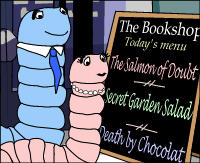The Bookworm Club Review
Created | Updated Apr 1, 2004

All reviews are written by members of The H2G2 Bookworm's Club. We hope this
review is helpful, and that we'll see you airing your
views at the Club soon.
Tipping the Velvet, Sarah
Waters
The Story
This is a tale of Victorian lesbianism. Nan, a girl from a
seaside town, falls for Kitty, a male impersonator from a
Variety show visiting the town. After a whirlwind romance she
follows Kitty to London, where she discovers a new exciting
world.
The Review
Overall I enjoyed it. Not especially inspired but
readable. I was impressed with the first section. Good use of
the iconography of lesbianism (throwing the flower to her;
very reminiscent of Marlena in Morocco), and the sense
of excitement and wonder mixed with innocence as the
narrator's sexual identity unfolds was well evoked. I also
liked the detail painted in to the world of the stage -
another rich setting in queer terms.
But I was disappointed. It didn't live up to its early
promise. The narrator is irritatingly passive and the pacing
is all over the place. I was particularly irritated by the
'evil rich lesbian' section. Not irritated that there was an
evil lesbian; I'm fine with that although I think she could
have done it a bit more cleverly. There is a long history of
'evil lesbian' figures to draw on, both in literature and
film but particularly in pulp fiction of the
fifties1 and it would have been nice to have seen
some of that in there. No, what irritated me was the clumsy
referencing. I found the name-dropping painfully obvious.
Slap me if I start to do that.
Interesting for the essay that is going to be on the
codifying of lesbianism in early 20th century
fiction. There were moments when it was done well. The evil
lesbian gives violets to the narrator and one of the flowers
falls off and gets stepped on. If you don't know the rich
symbolism that surrounds violets for a lesbian reader the
significance of that would probably pass you by. The nice
thing about that was that it didn't call attention to itself.
Nice if you get it but if you don't you wouldn't even notice,
so it doesn't skew the narrative.
Then there's the sex. And again I approve of lesbian sex
being depicted; it's all too often glossed over and that
makes it easier for the image of lesbians as non-sexual to
proliferate. But did she have to do it so badly? Since sex
was such a big element, I was expecting more of an arc. But
there was almost no development in either awareness or
technique. The descriptions were repetitive and the huge
range of discussions of lesbian sexual politics (particularly
the lesbian sex wars) was almost completely lacking. Not that
I'd want it to be overtly present, but that is exactly the
sort of thing that could have usefully inflected the
narrative.
The book has done something good though. It's been a
success. A mainstream success at that. And that is a big
problem. How do we write novels that speak to and of lesbian
lives but that don't alienate a wider non-lesbian audience.
The alternative has been faux lesbianism, dressed down with
all the authenticity taken out so as not to scare the hets
away. I know that to an intelligent reader of any sexual
persuasion it wouldn't matter. It doesn't have to be a
barrier to reading, enjoying and understanding a
novel2. But it's
surely not just for those that we write. It almost seems as
though if we write from a position of difference, any
difference, we must effectively write two books at once. That
is why I'm looking so hard at codification because I'm sure
that's the way to do it and I want to do it well. So the rich
layer of subtext, allusion and reference is there and
accessible if you have the tools for it. The important part
is to make it invisible to those who don't have access to
that range of experience and education that would let them
recognise it. If it's not invisible it disrupts the text and
the uninformed reader will feel left out, frustrated by the
shadows half glimpsed at the corners of the page. I think
Tipping the Velvet made that mistake and it didn't
solve the problem; it's too obvious in its references and I
think there's too much of it that panders to the het reader
and not enough of the subtlety that will speak to the queer
reader. But at least it tried and it was a success, at least
commercially. That's important if for no other reason than
that it chips away at the idea that fiction about queers is
only for queers.
The Bookworm Club
Review Archive
Review written by nadia
assembled by Z
paperback cover all in reds with the slogan 'satan is a
lesbian'.2Why should it be? I can identify with het
characters dammit so why shouldn't het readers find something
of themselves in queer characters?
